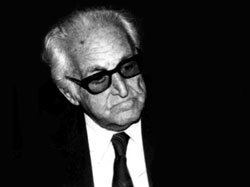Name Morteza Neydavoud | Role Musical Artist | |
 | ||
Died July 31, 1990, San Francisco, California, United States Similar People Qamar‑ol‑Moluk Vaziri, Darvish Khan, Ali‑Akbar Shahnazi, Morteza Mahjubi, Ali‑Naqi Vaziri | ||
Persian Music: 'Bayat Tork' by Morteza Neydavoud on Tar | مرتضی نیداوود چهار مضراب بيات ترك
Morteza Neydavoud (Persian: مرتضی نیداوود) (1900 – July 31, 1990) was a famous Iranian musician and music composer.
Contents
Life and work
He was born to a Persian Jewish family in Isfahan during the Qajar times. His family was satiated with music and he began to love music at an early age. His father Bala Khan played the tonbak, and the sound of instruments played by the musicians of the time echoed in their music-loving Persian Jewish household. Neydavoud taught himself to play the tar at an early age. Recognizing his son’s talent in music, the elder Neydavoud apprenticed the seven-year-old to Ramazan Khan Zolfaqari who was a student of the great master of the tar, Mirza Hossein-Qoli. After two years, Ramazan Khan took Morteza for further study with Hossein-Qoli.
In Hossein-Qoli's school, Neydavoud practiced the radif of the traditional music of Persia. After Hossein-Qoli's death, Neydavoud continued his musical education Hossein-Qoli's best student and successor, Darvish Khan, who completed Neydavoud's study of radif and proceeded to teach him other musical forms, such as "pishdaramad" (similar to overtures in Western classical music), zarbi (rhythmic pieces), and tasnif (similar in spirit, if not in exact form, to lieder). Neydavoud became Darvish Khan's best student and, as it was customary in those days, was given the title “Caliph" of the class.
Several years later, Neydavoud participated in concerts with his brothers, Mousa and Soleyman, and other notable musicians, such as Abolhassan Saba, Reza Mahjubi, Morteza Mahjubi, Arsalan Dargahi, Reza Ravanbakhsh, and Qamar-ol-Moluk Vaziri.
In addition to his concerts and recordings, Neydavoud established a school for music, which he named "Darvish". In 1940 he was invited, along with a group of other well-known musicians, to join the staff of Radio Iran. However, the bureaucratic administration of Radio Iran made it impossible for Neydavoud to maintain a free and productive career in the organization. Moreover, the political and economical climate of the time led to a sharp decline in the production of records and live performances. As a result, Neydavoud left the Radio and became reclusive at the height of his creativity and technical mastery. He continued his involvement with music only through a small circle of close friends, acquaintances, and private students. Neydavoud returned to the radio some thirty years later, when he finally accepted an invitation to record his version of the radif. Within a period of about one-and-a-half years, he meticulously recorded the radif as he remembered receiving it from his masters, resulting in a body of almost 300 audio cassettes.
In 1977 Neydavoud's family immigrated to the United States and took the seventy-seven-year-old master with them. This separation from his birthplace and the environment in which he had grown up had an adverse effect on the old master's well being. He died in California in 1990, thousands of miles away from home.
